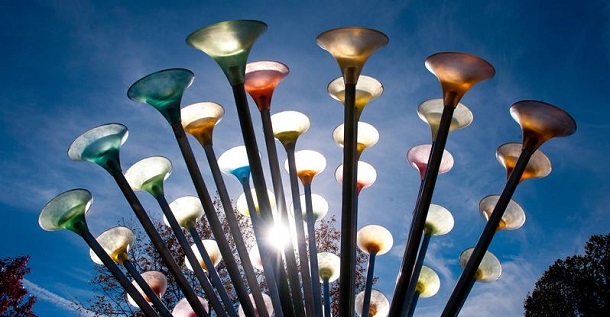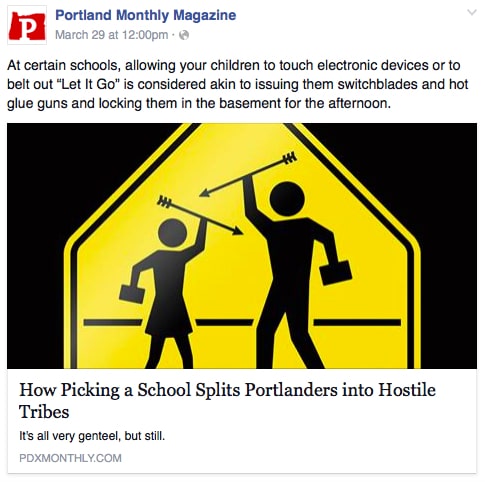Fair readers! We have two good-apology posts in a row!
A few days ago, Portland Monthly magazine caused offense by publishing a story with the headline, “How Picking a School Splits Portlanders into Hostile Tribes.” The piece was illustrated with a fake street sign featuring stick figures holding arrows.
You can see the original headline and a snippet of the original graphic on a March 29 Facebook post.
The piece itself was the kind of innocuous, toothless, semi-humorous piece about the difficulty of finding the right school for your kid and feeling judged no matter what you do that’s been written a zillion times, including by me. (Hey, the truth hurts.) The problem was the headline and graphic. The moment the magazine posted on Facebook, there were dismayed comments.
One noted:
Choosing to use arrows in your graphic is an easily correctable offense. It perpetuates a painful stereotype. I request that you change it.
Another said:
[C]asual racism (“micro” aggressions) often goes unnoticed, sadly, we all are guilty of this. The graphic and caption, both, willfully misrepresents the valid culture of the Original People and portrays us as generic mystics. Unfortunately, this sort of thinking only serves to perpetuate racism further… My point is not that these “casual” racisms are offensive to individual people — my point is that they contribute to systematic cultural racism as a whole. By just swallowing this stuff as no big deal or jocular we’re saying these stereotypes are OK………..and they’re not.
Shockingly, Portland Monthly agreed! And fast! The first FB comment occurred on March 30 at 12:41 pm. The piece was changed and an editor’s note and apology were up on April 1 at 9:41 am.
The headline: “An Apology from Portland Monthly.” The subhead: “The combination of an illustration and a headline in our April issue caused justifiable offense.” Yes! Good! Straightforward! Makes clear that they screwed up and people were right to be distressed!
Read the whole apology, but if you’re busy, here are the high notes:
- Editor Zach Dundas takes responsibility for the lapses in judgment. He names the offense and owns it. The first paragraph of the apology points out that the editors were responsible for the “hostile tribes” headline, not the writer. Way to NOT throw her under the bus.
- Dundas doesn’t equivocate about the wrongheadedness of the editorial decision. He says the magazine has “heard from numerous readers and Native American community leaders that this combination of words and images is offensive and derogatory, evoking negative stereotypes of Native Americans.” He doesn’t minimize or say it was only a couple of folks (whiny, humorless folks with two much time on their hands, people with an agenda, you know how they are); he says “numerous” people.
- Dundas uses the always-effective boldface type! “We erred in publishing this image and title, particularly in combination. We did not intend to offend any person or community, but in this case intention is beside the point. We have heard clearly that we caused pain, anger, and confusion among readers and communities we care about, and we are sorry.” Concise! Notes that not having racist intentions is not good enough! Notes that people were hurt (no use of the heinous phrases “if anyone was hurt” or “we apologize to those who may have been offended”). This is a semantic difference that matters: Dundas doesn’t apologize only to Native Americans or only to those distressed — his “we are sorry” does not have an object or qualifiers. This apology is for everyone, whether or not everyone complained or whether or not everyone regarded the imagery as offensive. Because, as Dundas notes, it was a mistake to publish the headline and image, and it was offensive.
- Fix the problem: Dundas does so by changing the headline and illustration. Now there’s a generic stock photo of a school bus (unimaginative, but it does the job) and the word “tribes” has been changed to “camps.” Better.
- An essential part of a good apology is explaining how the offense won’t be repeated. What steps are you taking? “I have had a number of conversations with Portland community leaders over the last couple of days. Those conversations have been humbling and wrenching at times, and I’m grateful for the time and consideration they demanded of those involved. I will work to keep those dialogues going and to devise a constructive way for our editorial staff to improve and expand our coverage of Portland’s Native American communities and other communities of color, which is always one of our journalistic goals.” Good! Dundas again takes specific and personal responsibility: “I thought the motifs in play functioned as universal metaphors. Given our specific context—in Portland, Oregon, and western North America—I now understand that I thought wrong. I apologize.”
There’s more, which you should read. Dundas notes his personal history with the Flathead Indian Reservation and the Confederated Salish and Kootenai Tribes, but not in a SOME OF MY BEST FRIENDS ARE INDIANS way. He says only, “I have written about Native American people and issues many times, and the last few days have provided an opportunity to reflect on how that admittedly limited experience has enriched my life and career.” Rather than being defensive about screwing up, he thinks about the ways diversity has helped him grow as a journalist. This is good. As is the conclusion: “[W]e’ll work to do better next time.” Acknowledge your mistake, name it, fix it as best you can (the online version was changed quickly, and the magazine will publish an editor’s note in its June issue, the soonest it can do so), take action to be sure the problem doesn’t recur. Yes, yes, yes, and yes.
An aside: The question of how to correct an online article is an interesting one. These days, stories are edited, sometimes several times, after they go up. This can be a problem Readers deserve to know how and why changes are made, and news outlets are not always forthcoming. In this case, if Dundas had merely changed the headline and art (and even if he’d apologized for them without saying exactly why), there would have been no record of precisely what happened. The bad stuff would be erased, but we’d all have been denied a teachable moment, a way to reflect on both the magazine’s hurtful thoughtlessness and on the times we’ve done something similar.

HALLELUJAH! HALLELUJAH!


Yeah, agreed, that’s an excellent apology.
Also, in my opinion, it’s extremely useful that SW takes the trouble to acknowledge the good apologies, as well as to castigate the bad ones.
For all the reactionary hand-wringing about “call-out cultures” and interweb “mobs,” this is as fine an example as any of how a movement actually succeeds, by introducing into the collective conscience explicit framework for how to (a) not fuck up so often*, (b) recognize when you do, and (c) address the root cause of the fuck-up as near as you can, thereby making the world a better place, ridding it of future fuck-ups.
The system works (and–surprise!–nobody got “lynched” by SJW bullies)! Thank you to this blawg and its masters for contributing to that.
*fucking up is inevitable
Wow. That’s the most… humility and honesty I’ve seen in an apology for awhile. It’s kind of blindsiding.
Clearly, the Apocalypse is nearly upon us.